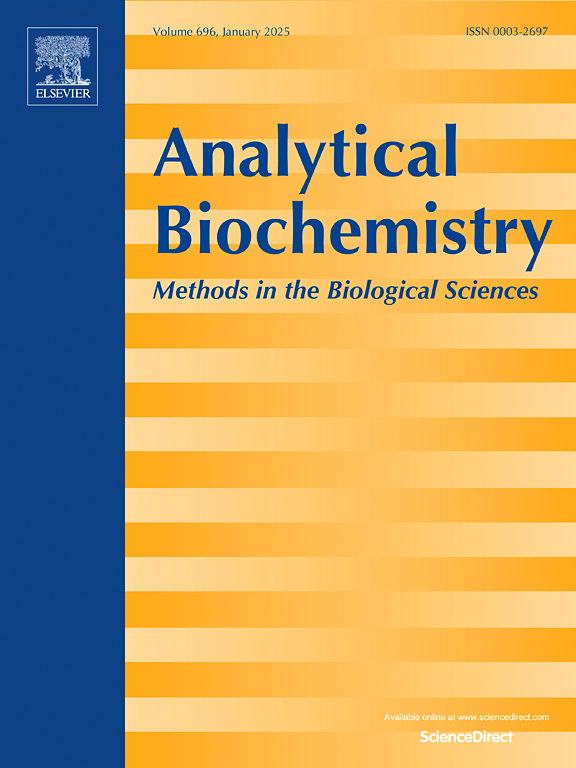Innovative determination of Let-7a for lung cancer diagnosis using a duplex specific nuclease (DSN)-based electrochemical biosensor
IF 2.6
4区 生物学
Q2 BIOCHEMICAL RESEARCH METHODS
引用次数: 0
Abstract
In this study, we emphasize the importance of identifying Let-7a, a microRNA that is key in diagnosing and predicting lung cancer outcomes. Let-7a′s function as a biomarker is essential, as it affects tumor suppression and controls cell differentiation and growth. We developed a novel device, an electrochemical biosensor based on Duplex Specific Nuclease (DSN), that is designed for the accurate detection of Let-7a. This biosensor has a very low detection limit of 3.9 aM, showing its high sensitivity. The design is easy to use, requiring little training to operate. Its small size and portability enable the possibility of bedside and home use, which is a significant improvement for personalized healthcare. This versatility of the biosensor is very promising, as it can be applied to other disease biomarkers besides lung cancer. We expect this technology to improve disease diagnosis and patient recovery tracking, playing an important role in the future of medical diagnostics. The use of such sensitive and specific biosensors can transform the way diseases are managed, providing timely and precise information on disease progression and treatment effectiveness. The potential for this technology to help advance personalized medicine and patient care is huge, creating new opportunities in medical diagnostics and therapy monitoring.

基于双特异性核酸酶(DSN)的电化学生物传感器对肺癌诊断中Let-7a的创新测定。
在这项研究中,我们强调了鉴定Let-7a的重要性,这是诊断和预测肺癌预后的关键microRNA。Let-7a作为一种生物标志物的功能是必不可少的,因为它影响肿瘤抑制和控制细胞分化和生长。我们开发了一种新的装置,一种基于双工特异性核酸酶(DSN)的电化学生物传感器,用于精确检测Let-7a。该生物传感器的检测限很低,仅为3.9 aM,具有很高的灵敏度。该设计易于使用,几乎不需要培训就可以操作。它的小尺寸和便携性使床边和家庭使用成为可能,这是个性化医疗保健的重大改进。这种生物传感器的多功能性非常有前景,因为它可以应用于肺癌以外的其他疾病生物标志物。我们期望这项技术能够改善疾病诊断和患者康复跟踪,在未来的医疗诊断中发挥重要作用。使用这种敏感和特异的生物传感器可以改变疾病管理的方式,提供关于疾病进展和治疗效果的及时和精确的信息。这项技术帮助推进个性化医疗和患者护理的潜力是巨大的,在医疗诊断和治疗监测方面创造了新的机会。
本文章由计算机程序翻译,如有差异,请以英文原文为准。
求助全文
约1分钟内获得全文
求助全文
来源期刊

Analytical biochemistry
生物-分析化学
CiteScore
5.70
自引率
0.00%
发文量
283
审稿时长
44 days
期刊介绍:
The journal''s title Analytical Biochemistry: Methods in the Biological Sciences declares its broad scope: methods for the basic biological sciences that include biochemistry, molecular genetics, cell biology, proteomics, immunology, bioinformatics and wherever the frontiers of research take the field.
The emphasis is on methods from the strictly analytical to the more preparative that would include novel approaches to protein purification as well as improvements in cell and organ culture. The actual techniques are equally inclusive ranging from aptamers to zymology.
The journal has been particularly active in:
-Analytical techniques for biological molecules-
Aptamer selection and utilization-
Biosensors-
Chromatography-
Cloning, sequencing and mutagenesis-
Electrochemical methods-
Electrophoresis-
Enzyme characterization methods-
Immunological approaches-
Mass spectrometry of proteins and nucleic acids-
Metabolomics-
Nano level techniques-
Optical spectroscopy in all its forms.
The journal is reluctant to include most drug and strictly clinical studies as there are more suitable publication platforms for these types of papers.
 求助内容:
求助内容: 应助结果提醒方式:
应助结果提醒方式:


